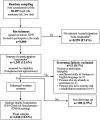Evaluation of a validated questionnaire to assess the need for prevention or rehabilitation by preventive health examinations: a cross-sectional study of German employees aged 45 to 59 years (Ü45-check)
- PMID: 40740350
- PMCID: PMC12307417
- DOI: 10.3389/fpubh.2025.1480312
Evaluation of a validated questionnaire to assess the need for prevention or rehabilitation by preventive health examinations: a cross-sectional study of German employees aged 45 to 59 years (Ü45-check)
Abstract
Objective: A longer life expectancy can lead to a longer working life and is therefore important for the individual and the healthcare system. Therefore, a study group established a Risk-Index Disability-Pension (RI-DP), which assesses the risk of work disability. However, a standardized and well-founded preventive health examination does not yet exist in Germany. Hence, we developed a preventive health examination conducted by physicians and compared it with a questionnaire survey to examine its differences and results in relation to the need for prevention and rehabilitation, taking into consideration the RI-DP.
Methods: In this prospective cross-sectional study, n = 1,040 participants (45-59 years) took part in a preventive health examination at the Charité - Universitätsmedizin Berlin/Humboldt-Universität zu Berlin, Germany. A questionnaire survey and preventive health examination, including anthropometric measures, anamnesis, cardiovascular examinations, and blood samples, were conducted independently to determine the need for prevention and rehabilitation.
Results: The mean age was 52.93 (sd = 4.17) years, and n = 631 (61%) were men. The questionnaire assessed n = 733 (70%) participants as needing no additional action (green), n = 215 (21%) as needing a prevention program (yellow), and n = 91 (9%) as needing a rehabilitation program (red). In contrast, physicians assessed n = 141 (14%) as 'green', n = 717 (69%) as 'yellow', and n = 181 (17%) as 'red', revealing substantial discrepancies, especially in preventive needs. The leading associations of individual factors on physicians' evaluation were BMI [OR 1.135 (1.094; 1.178)], SBP [OR 1.099 (1.009; 1.197)], smoking status [OR 1.691 (1.212; 2.366)], depressive moods [OR 2.254 (1.565; 3.254)] and physical activity 1-2 h/week [OR 0.618 (0.436; 0.874)], and on the questionnaire: gender male [OR 1.790 (1.057; 3.046)], and depressive moods (OR 4.506 [3.216; 6.322]). This underlines the complementary nature of the two approaches in evaluating health interventions. According to the RI-DP, the participants had the following risk of early retirement: low-risk n = 540 (52%), medium-risk n = 307 (30%), and high-risk n = 193 (19%).
Conclusion: The results emphasize the need for combining questionnaire surveys with preventive health examinations to assess health needs comprehensively. Notably, the preventive health examination suggests higher prevention needs compared to the questionnaire, indicating that the questionnaire may not fully capture clinical prevention needs.
Clinical trial registration: https://drks.de/search/de/trial/DRKS00030982, identifier DRKS00030982.
Keywords: disability pension; prevention; questionnaire; rehabilitation; screening; work disability; Ü45-check.
Copyright © 2025 Kalski, Pulst Caliman, Greiß, Karathanos, Hafermann, Völkel, Pächter, Herrmann, Hofmann and Wolfarth.
Conflict of interest statement
The authors declare that the research was conducted in the absence of any commercial or financial relationships that could be construed as a potential conflict of interest.
Figures



References
-
- von Nordheim F, Kvist J. Regulating the retirement age—lessons from Nordic pension policy approaches. Regul Governance. (2023) 17:644–57. doi: 10.1111/rego.12475 - DOI
-
- International A. aging readiness & competitiveness report: Japan . (2017).
MeSH terms
LinkOut - more resources
Full Text Sources

